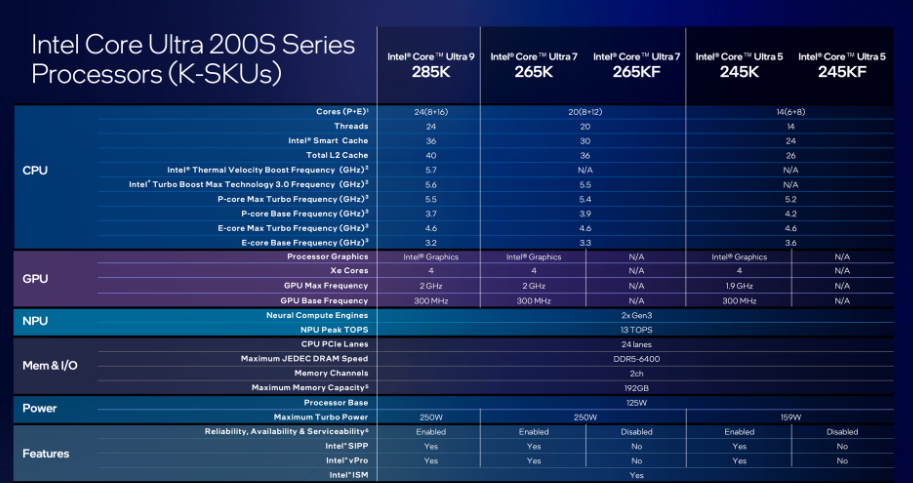Intel Core Ultra 200S: A Revolutionary Leap in Desktop CPUs with AI Integration
Intel’s Core Ultra 200S processors are creating waves in the tech community with a powerful blend of advanced AI capabilities, improved power efficiency, and a bold shift in design philosophy. These processors bring desktop PCs closer to the AI-driven future, offering new levels of performance, customization, and efficiency. If you’re interested in cutting-edge technology, you’ll want to know how Intel’s Arrow Lake processors are pushing the boundaries in the desktop CPU market.

In this article, we’ll break down the groundbreaking features of the Intel Core Ultra 200S processors, explore how they compare to previous generations, and examine what makes them a significant upgrade for both casual users and power-hungry enthusiasts.
What’s New with Intel Core Ultra 200S?
With its Arrow Lake architecture, the Intel Core Ultra 200S series marks a major leap forward in CPU technology. The introduction of AI-powered NPUs (Neural Processing Units) and an overhauled chiplet design significantly enhances efficiency and performance. But what does all this mean for users?
1. Chiplet-Based Design for Enhanced Efficiency

The Core Ultra 200S series adopts a chiplet-based architecture, leveraging Intel’s Foveros packaging technology. This design consists of multiple silicon dies bound together, optimizing communication between key components and dramatically boosting overall performance. The layout includes:
- Compute Tile: Dedicated to the CPU cores, delivering the primary processing power.
- GPU Tile: Handles graphics cores, delivering impressive integrated graphics performance.
- SoC Tile: Manages the NPU, video encoding, decoding, and display outputs.
- I/O Tile: Takes care of memory controllers and various input/output functions.
By separating these components into specialized tiles, Intel achieves better power distribution and allows for modular upgrades in future releases. This architecture ensures that the processor uses power more efficiently without compromising performance.
2. First Desktop Processors with NPUs

For the first time, Intel has integrated an NPU into its desktop processors. This feature, previously available only in laptop CPUs like Meteor Lake and Lunar Lake, opens the door to accelerated AI and machine learning tasks. The NPU can handle up to 13 trillion operations per second (TOPS), enabling faster data processing for AI-driven applications like content creation, gaming, and real-time analytics.
Although Intel’s NPU doesn’t meet the 40 TOPS requirement for Microsoft’s Windows 11 Copilot+ features, it’s still a major step forward for desktop AI capabilities. The processor is well-equipped for current AI tasks such as image processing, voice recognition, and video enhancement, offering new possibilities for creative professionals and tech enthusiasts alike.
A Closer Look at Performance: P-Cores vs. E-Cores

Intel’s Core Ultra 200S processors feature a hybrid architecture that combines P-cores (Performance Cores) and E-cores (Efficiency Cores). This dual-core design balances high-performance tasks and power efficiency. Let’s break it down:
1. Performance Cores (P-Cores)
These cores, based on the Lion Cove architecture, focus on high-demand tasks such as gaming, video editing, and intensive multitasking. They deliver about 9% more instructions per clock (IPC) compared to the previous Raptor Cove architecture, even though the maximum clock speed is slightly reduced.
However, the P-cores lack hyper-threading, meaning each core supports only one thread. Despite this, Intel argues that the space saved by eliminating hyper-threading is better used for more E-cores, which can handle multi-threaded tasks just as efficiently.
2. Efficiency Cores (E-Cores)

E-cores are the unsung heroes of the Arrow Lake architecture. These cores, based on Skymont architecture, deliver impressive results in multi-threaded tasks while consuming less power. Intel claims a 32% performance boost in integer workloads, 72% in single-core floating-point workloads, and 55% in multi-core floating-point tasks compared to their predecessors.
Together, P-cores and E-cores create a seamless system that switches between high-performance and low-power modes based on workload requirements, making the Core Ultra 200S one of the most adaptable desktop processors available.
Power Efficiency: A Game-Changer
Intel’s Arrow Lake processors are engineered to tackle one of the biggest challenges in modern computing: power consumption. After the power-hungry 13th- and 14th-generation CPUs, the Core Ultra 200S lineup brings significant improvements in energy efficiency.
Intel claims the Core Ultra 200S processors use 30% less power while offering a 10% performance boost in multi-core tasks. These gains are even more impressive in gaming scenarios, where power consumption is reduced by an average of 73 watts, while the system runs 13°C cooler.
For eco-conscious users and gamers, this means lower electricity bills and a quieter, cooler system. Less heat also translates to better longevity for your hardware.
Intel Core Ultra 200S Lineup: Performance Breakdown
The Core Ultra 200S series features several distinct processors, all of which cater to different types of users. Whether you’re a content creator, gamer, or multitasker, there’s a model designed for your needs.
| Processor | Cores (P/E) | Threads | Max Boost | Price (USD) |
| Intel Core Ultra 9 285K | 8 P, 16 E | 24 | 5.7 GHz | $589 |
| Intel Core Ultra 7 265K | 8 P, 12 E | 20 | 5.5 GHz | $394 |
| Intel Core Ultra 7 265KF | 8 P, 12 E | 20 | 5.5 GHz | $379 |
| Intel Core Ultra 5 245K | 6 P, 8 E | 14 | 5.2 GHz | $309 |
| Intel Core Ultra 5 245KF | 6 P, 8 E | 14 | 5.2 GHz | $294 |
Each processor is overclockable, and all include Intel’s Xe integrated graphics, except for the KF variants, which omit the GPU in Favor of lower prices. The 285K, 265K, and 245K are designed to deliver a high-performance experience for demanding users, while the 265KF and 245KF provide budget-conscious consumers with a streamlined option.
Gaming and AI: Does It Deliver?
While Intel’s marketing heavily emphasizes AI enhancements, the Core Ultra 200S lineup isn’t all about neural networks. Gamers will be pleased to know that these processors bring some noticeable improvements to frame rates, even if the gains are modest.

1. GPU Improvements
Intel’s integrated Xe GPU delivers twice the performance of the older UHD 770 graphics cores. This may not turn your desktop into a gaming powerhouse on its own, but it’s a great option for light gaming, creative work, and media consumption. Features like ray tracing and XeSS upscaling bring higher-end features to the integrated graphics world, although serious gamers will still want to pair these processors with a dedicated GPU for AAA titles.
2. AI in Gaming and Content Creation
With AI at the heart of these processors, gamers and content creators can expect more intelligent and efficient performance. The NPU allows for AI-driven enhancements such as real-time in-game adjustments, upscaling graphics, or automating repetitive content creation tasks.
For example, AI tools powered by the NPU can assist streamers by optimizing video quality, enhancing voice clarity, and even generating assets on the fly, all without taxing the main CPU or GPU.
Intel’s Future: What Arrow Lake Means for AI and Desktop Computing
Intel’s Arrow Lake architecture is more than just an upgrade it signals a shift toward an AI-driven future. As more applications and games leverage AI, desktop users will increasingly demand processors that can handle these tasks without compromising performance.
Although Intel’s Core Ultra 200S processors aren’t compatible with Microsoft’s Copilot+ due to NPU limitations, they still represent a significant step forward. The inclusion of NPUs is just the beginning, and we can expect future generations to further enhance AI capabilities, making them indispensable in the modern computing landscape.
FAQs
1. What is the Intel Core Ultra 200S series? The Core Ultra 200S is Intel’s latest desktop CPU series featuring AI-powered NPUs, improved power efficiency, and a chiplet-based architecture. It’s part of Intel’s Arrow Lake lineup.
2. How do NPUs benefit desktop users? NPUs accelerate AI and machine learning tasks, making them ideal for content creation, gaming, and real-time analytics. They free up CPU and GPU resources, allowing for smoother performance in AI-driven applications.
3. How does the Core Ultra 200S compare to previous generations? Compared to the 13th- and 14th-generation Intel processors, the Core Ultra 200S series offers a 10% performance boost in multi-core tasks while using 30% less power. Gaming performance remains similar but with significantly lower power consumption.
4. What are the key features of the Core Ultra 200S? Key features include the chiplet-based design, NPUs for AI processing, Xe integrated graphics, support for DDR5 memory, and up to 24 PCIe 5.0 lanes.
5. Are these processors good for gaming? While the integrated Xe GPU is a significant upgrade, it’s still not meant for high-end gaming. However, gamers using





